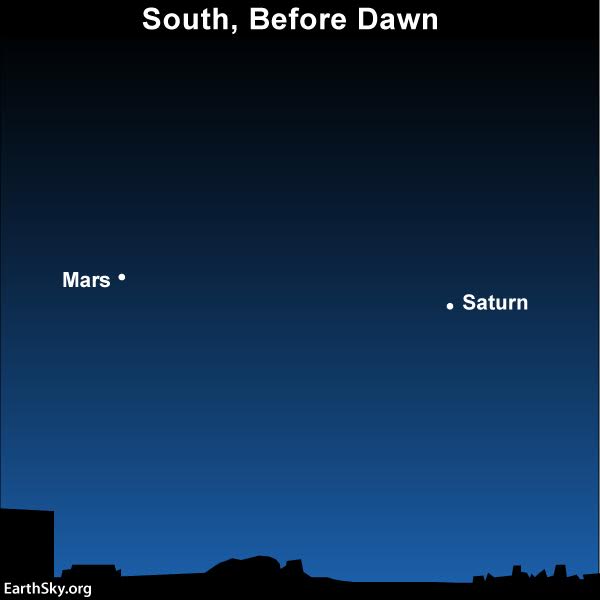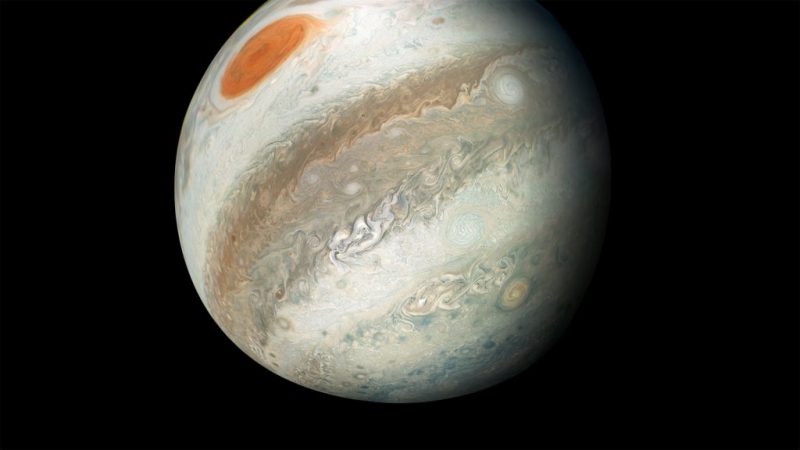On May 25 to 28, 2018 – if you have a clear sky – you’ll surely notice a very bright “star” near the moon. This object is really a planet, Jupiter. Once Venus sets in the west, not long after the sun, the moon and Jupiter are the two brightest objects in the nighttime sky.
On some of these nights, you might notice a fainter true star, still one of our sky’s brightest stars, Spica – in the moon’s glare. Spica is the brightest star in the constellation Virgo the Maiden, and it’s a key star of the zodiac. Though a 1st-magnitude star, Spica is some 20 times fainter than Jupiter. But Jupiter’s brightness stems from its relative nearness to Earth, while Spica is a distant star, some 262 light-years away.
Spica’s magnitude is virtually the same as that of Antares, another key star of the zodiac. Want to compare them, but don’t know how to recognize Antares? Jupiter resides roughly midway between these two bright stars, and the moon will travel close to Antares on the sky’s dome on May 28, as shown on the sky chart above.
Notice how nearly full and round the moon appears in our sky this weekend. Jupiter and the moon will be closest on May 27, and the moon will be full on May 29. Meanwhile, this is Jupiter’s opposition month; that is, Earth just flew between Jupiter and the sun, placing Jupiter opposite the sun in our sky. A full moon is also opposite the sun as seen from Earth.
Thus it’s no accident that Jupiter is close on the sky’s dome to this nearly full moon around now. Both Jupiter and the moon are, more or less, opposite the sun.

Two months from now – on July 27, 2018 – it’ll be Mars’ opposition, its first opposition in two years and its best one since 2003. Jupiter is brighter than Mars now, but just wait! From about July 7 to September 7, 2018, Mars will supersede Jupiter in brightness … and it’ll shine with a red color!
In fact, in late July, Mars will shine better than 30 times brighter than stars like Spica and Antares, two of the brightest stars in our sky.
You can see Mars tonight, if you’re willing to stay up late or wake up early. It’s a noticeably bright “star” in the sky before dawn, near another planet, Saturn.

Back to the moon and Jupiter, though. You know the moon appears much larger than Jupiter in our sky. But that’s only because the moon is so much closer to Earth than Jupiter. At present, the moon lies nearly 245,000 miles (394,000 km) away, while Jupiter lies far beyond the moon, at nearly 1,700 times the moon’s distance from Earth. Click here to know the moon’s present distance from Earth in kilometers, miles or astronomical units (AU). Click here or click here to find out Jupiter’s present distance from Earth in astronomical units (AU).
Jupiter is truly the giant world of our solar system. In fact, Jupiter’s volume is greater than 1,300 Earths or 66,000 Earth-moons!
Jupiter is also some 318 times more massive than our planet Earth. The king planet is more than twice as massive as all the other solar system planets, dwarf planets, minor planet and moons combined.
Think about that as you see this great planet in the moon’s glare in the coming nights!

Bottom line: On the nights of May 25 to 28, 2018, the giant planet Jupiter is the brightest object in the moon’s vicinity. Spica in the constellation Virgo – and Antares in the constellation Scorpius – are also nearby.












